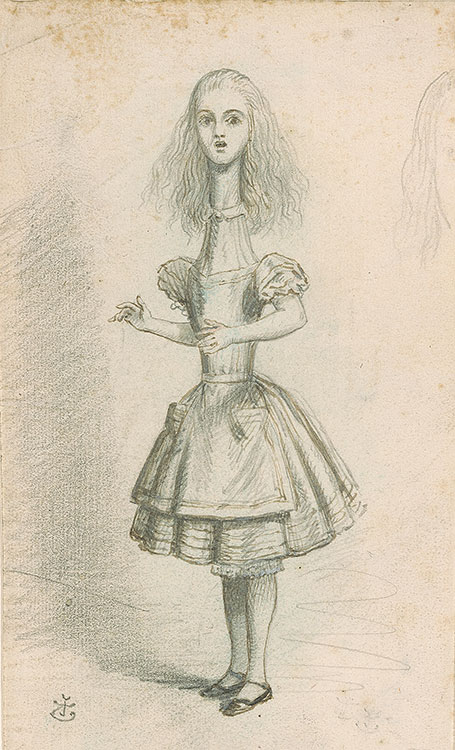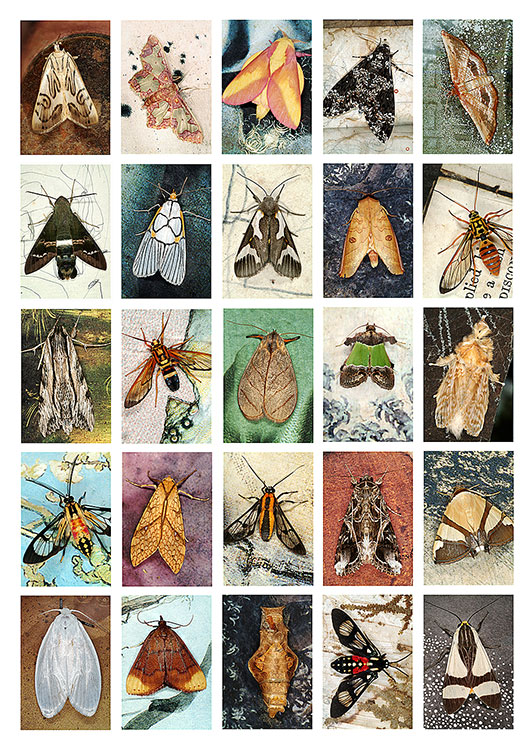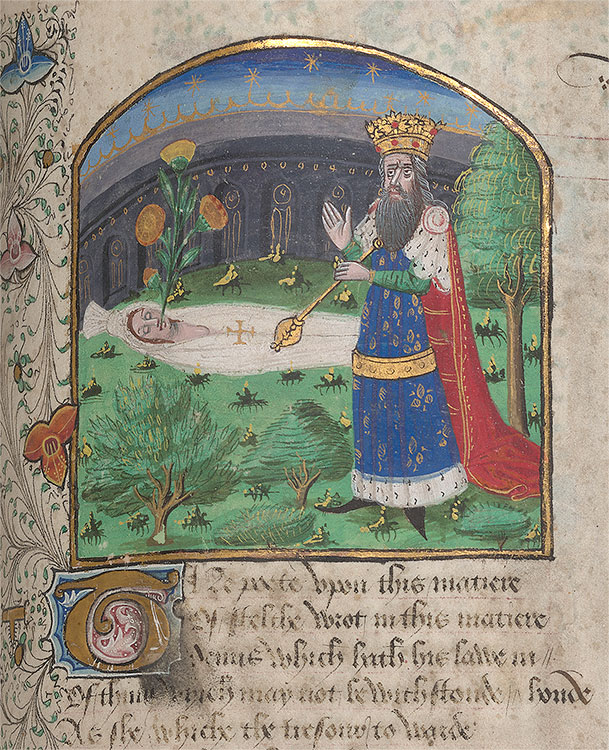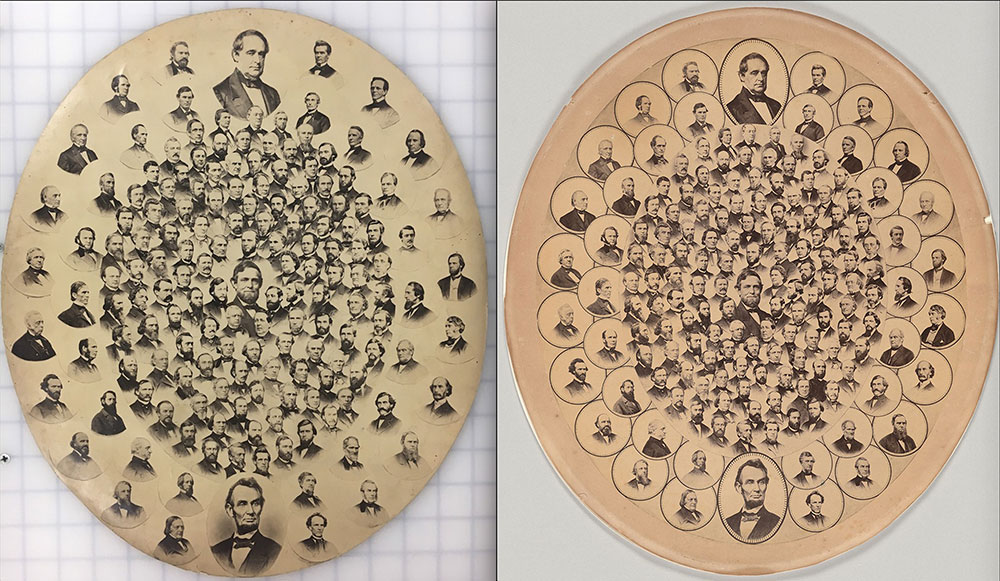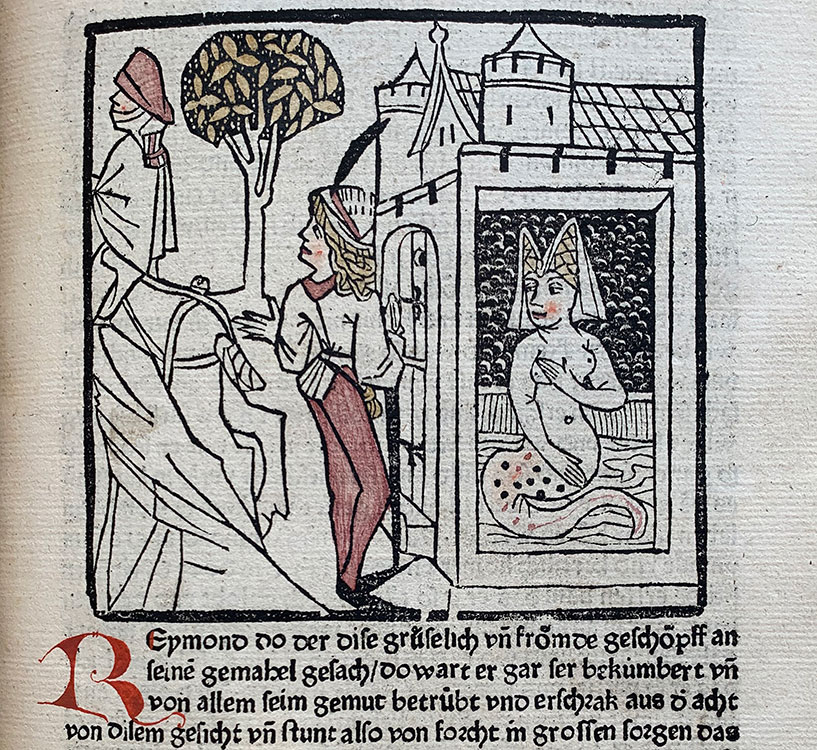Morganmobile: Metamorphosis
In art, in nature, and in society, formation entails transformation. From Ovid and his centuries of visual interpreters to the modern shape-shiftings of surrealism, artists—and those who work to conserve art—have reflected the intuition that metamorphosis is constant, and that nothing is constant but change.
Morganmobile: Metamorphosis
John Tenniel's iconic image of Alice's “telescoping” body—shown here in a preparatory drawing—illustrates one of several moments in Lewis Carroll's novel when Alice questions her identity. Adjusting to her outward change, she wonders whether it was preceded by an internal metamorphosis: “Was I the same when I got up this morning? … But if I’m not the same...Who in the world am I?” Beginning shortly after its publication in 1865, Alice’s Adventures in Wonderland was adapted to other genres and mediums, including nursery tales, plays, games, lantern slides, and films. Although Carroll authorized several adaptations, some were unlicensed, with art that exhibits slight changes to Tenniel's designs—just enough to avoid charges of copyright infringement.
John Tenniel (1832–1914), Alice Grown Tall, ca. 1860s. Graphite, pen, and brown ink on wove paper. Gift of Mr. and Mrs. Benjamin Gale, 1982.11:2.
Morganmobile: Metamorphosis
In 1918 Irving Berlin, then a soldier in basic training, adapted melodic components from an earlier composition to create a World War I victory song called “God Bless America.” Twenty years later, facing the rise of Hitler, Berlin revised his lyrics and introduced the song as an anthem for peace on a 1938 Armistice Day broadcast by radio star Kate Smith, whose inscription graces this copy. In 1940, folk singer Woody Guthrie critiqued Berlin’s song in one of his own, called “God Blessed America For Me,” later renamed “This Land is Your Land.” Berlin's iconic song has figured prominently in many contexts in American life, from the civil rights and conservative Christian movements to the National Hockey League.
Irving Berlin (1888–1989), “God Bless America,” New York: Irving Berlin Inc., 1939. James Fuld Music Collection, 2008.
Morganmobile: Metamorphosis
Medieval illuminations are known for surfaces of shimmering gold and brilliant color that delight the eye. A technology-aided glimpse through the surface reveals underdrawings in graphite or lead, made as guides for the artist. In this instance, infrared imaging highlights differences between the start and the finish of the illumination. For example, the musculature of the figure at lower left was worked out in great detail before being draped in blue cloth. Christ’s wounds, not indicated in the underdrawing, were added later during the painting process.
“Lallemant Missal,” in Latin, Tours, France, ca. 1500, illuminated for Guillaume Lallemant, canon and archdeacon of Tours, by Jean Poyer. Left: color image capture. Right: Pixelteq SWIR image capture at 1557 nm by Justine Provino and Abigail Merritt.
Morganmobile: Metamorphosis
In the Metamorphoses (I:151–176), Ovid tells of the Giants, aggressive children of Gaia who piled mountain on mountain to reach the stars and seize the heavens from the Olympian gods. In response, Jupiter hurled his thunderbolts, shattering the mountains and toppling the Giants below. The Earth then transformed the Giants’ blood into a new form of being: humans. With a characteristically agitated pen line and elongated figures, the sculptor Guglielmo della Porta depicts the Giants tumbling in a defeated mass below the deities. Guglielmo rendered sixteen episodes from the Metamorphoses as designs for plaquettes. Several cast versions of these plaquettes are known, including a complete set in bronze in the Kunsthistorisches Museum, Vienna.
Guglielmo della Porta (ca. 1500–1577), The Defeat of the Giants, ca. 1560–70. Pen and brown ink over black chalk on laid paper, 7 1/8 x 10 5/16 inches (181 x 262 mm). Purchased by J. Pierpont Morgan (1837–1913) in 1909, I, 33.
Morganmobile: Metamorphosis
The beauty of the lepidoptera is matched by their dramatic life cycle: caterpillars pupate and emerge as winged adults, staggering in their variety. Emmet Gowin makes mosaics of living moths—nocturnal cousins to the butterflies—in which the normally austere genre of typological photography undergoes metamorphosis, too. The portraits are made by lamplight in the rainforest. Rather than visually mimicking scientific method (or the taxonomist’s case of pinned specimens) by showing each species in matching position against a bare surface, Gowin lets the moths alight upon inkjet printouts he brings along. His backdrops showcase some of humanity’s boldest displays: details of ornament, Leonardo’s handwriting, canvases by van Gogh. Each grid (such as this one, from Bolivia) unites twenty-five transitory marriages between nature and culture.
Emmet Gowin, Mariposas Nocturnas: Index #44, Bolivia, 2011. Inkjet print, 13 5/8 x 9 1/2 in. (34.61 x 24.13 cm). Gift of Emmet and Edith Gowin, 2015.143.
Morganmobile: Metamorphosis
Conservation treatment transformed a beautifully worked graphite-pencil landscape by Thomas Gainsborough that was considered too damaged to exhibit. The graphite had not changed over time, but the aging paper had darkened and yellowed, reducing contrast and interfering with the legibility of the drawing. Stains and discoloration on the paper were removed by a washing treatment, making the image easier to read and restoring the sparkle of sunlight the artist had achieved by leaving portions of the sheet untouched.
Thomas Gainsborough (1727–1788), Landscape with a Decayed Willow over a Pool, 1754–1756. Graphite with smudging on laid paper. Purchased by J. Pierpont Morgan (1837–1913) in 1909, inv. III, 47
Morganmobile: Metamorphosis
Fourteenth-century English poet John Gower took Ovid’s Metamorphoses as the main source for his Confession of the Lover, but he made changes of his own to the first-century Roman’s magnum opus. In Gower’s retelling, King Orchamus learns that his daughter, Leucothoe, has been seduced by the sun god, Phebus, and he orders her buried alive to warn other maidens to guard their virginity. A saddened Phebus transforms his late beloved into a sunflower (as opposed to Ovid’s frankincense), which will always face the sun. In the miniature, the slain Leucothoe lies in her shroud. It opens at her head, allowing a sunflower to bloom, while Orchamus swings incense over her grave. Today, a genus of about fifty species of flowering plants bears the name Leucothoe.
John Gower, Confessio amantis, in Middle English and Latin, England, [London], ca. 1470, possibly commissioned for Elizabeth Woodville, queen of England and wife of King Edward IV; MS M.126, fol. 129 (det.). Purchased by J. Pierpont Morgan (1837–1913), 1903.
Morganmobile: Metamorphosis
In his haunting drawing Leaves Turned into Children, the Russian-American Surrealist Pavel Tchelitchew conjures an image of foliage metamorphosing into human figures. The faces and limbs of several children appear within the folds of leaves, as if emerging from oversized cloaks. While suggesting an apt metaphor for the awkward adjustments of adolescence, Tchelitchew’s image goes further, dissolving the boundary between the human form and the rest of the natural world.
Pavel Tchelitchew (1898–1957), Leaves Turned into Children, 1939. Pen and ink with wash, 11 13/16 x 8 3/4 inches (30 x 22.2 cm). The Joseph F. McCrindle Collection, 2009.311.
Morganmobile: Metamorphosis
While fire rains down from heaven, destroying the cities of Sodom and Gomorrah, Lot flees with his wife and daughters. Angels leading them to safety warn them not to stop or look back, but Lot’s wife cannot resist. As divine punishment for her disobedience, she is turned into a pillar of salt. Forever frozen in place with arms outstretched, her briny figure is licked by two rams.
Psalter, Latin and French, Tournai, Belgium, ca. 1200, MS M.338, fol. 196v (detail). Purchased by J. Pierpont Morgan (1837–1913) in 1908.
Morganmobile: Metamorphosis
Side-by-side scenes on this five-thousand-year-old cylinder seal depict leather workshops, where nude men work with mallets and animal skins. The scenes are divided by entwined serpo-felines, fantastic composite creatures with bodies and heads of lions and long twisting serpent necks. The combined qualities of feline and reptile produce a creature stronger than any real-world being. The serpo-felines act as guardians of an enterprise that was closely associated with the spiritual, social, and economic center of the community: the temple. The nudity of the workmen emphasizes the ritualization of labor itself as part of the temple economy.
Ancient cylinder seal with modern impression: Leather Workers in Rooms Framed by Serpo-Felines, Mesopotamia, Late Uruk period (ca. 3500–3100 b.c.); serpentine. Overall: 1 3/16 x 1 in. (3 x 2.5 cm.). Morgan Seal 1. Acquired by Pierpont Morgan sometime between 1885 and 1908.
Morganmobile: Metamorphosis
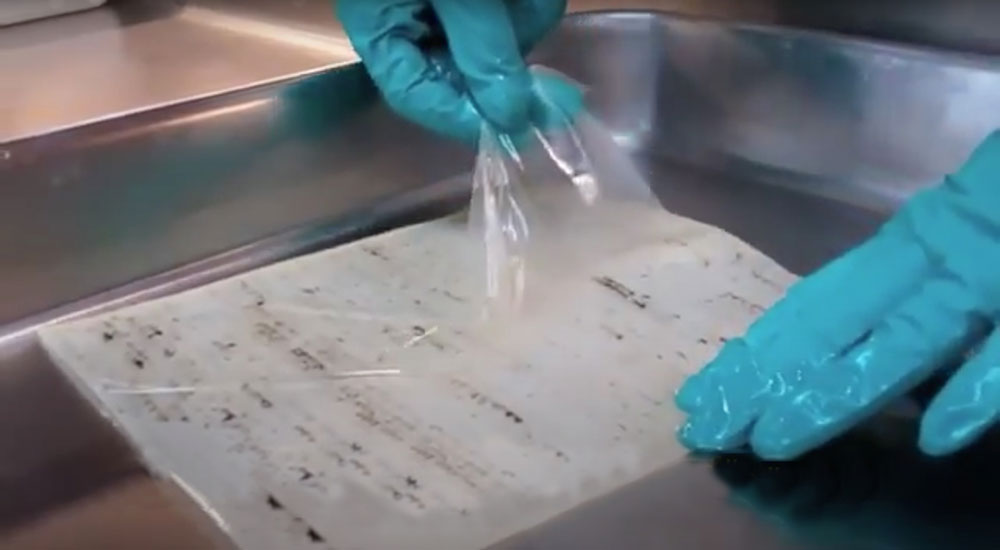
Understanding of materials evolves, and sometimes procedures that were intended to preserve collection objects must be undone. In this photograph, a layer of silk adhered to the back of a page of the manuscript of A Christmas Carol is being carefully removed by a paper conservator in the Thaw Conservation Center. In the early twentieth century, “silking” was believed to strengthen paper. It is now known that silk and the adhesive used to attach it can become brittle, interfering with the natural robustness of handmade paper. “Desilking” the paper leaves it more flexible and more likely to endure for many years to come.
Conservator desilking a sheet from Charles Dickens (1812–1870), A Christmas Carol in Prose: Being a Ghost Story of Christmas, autograph manuscript, December 1843. MA 97. Purchased by J. Pierpont Morgan (1837–-1913) before 1900.
Morganmobile: Metamorphosis
Willem van Mieris depicts the early Golden Age described in Ovid’s Metamorphoses (I:89–114). This idyll of constant spring, abundance, and untouched nature will ultimately evolve into an age of iron, characterized by greed and aggression. The refined drawing not only reveals the technical virtuosity of the artist, who co-founded the Leiden Drawing Academy, but, in a subtle form of graphic metamorphosis, conjures the visual effect of an etching.
Willem van Mieris (1662–1747), The Golden Age: Ovid “Metamorphoses,” I:89–-150, 1689. Point of brush and black ink and wash over graphite on laid paper; framing line in graphite, 5 3/4 x 7 3/8 inches (14.6 x 18.8 cm). Purchased by J. Pierpont Morgan (1837–1913) in 1909, I, 162.
Morganmobile: Metamorphosis
To commemorate passage of the Thirteenth Amendment, Philadelphia publisher Powell & Co. marketed an oval photomontage composed of government-issued portraits of those who had voted to end slavery. In the draft and final versions seen here, senators and leaders of the executive branch frame an inner scrum of representatives surrounding the speaker of the house. Between the January 1865 congressional vote and ratification by the states eleven months later, a change in circumstances rendered this roster historical. When Abraham Lincoln was assassinated in April, he was replaced not by Hannibal Hamlin (his first vice president, who surmounts the composition) but by Hamlin’s briefly serving successor, Andrew Johnson.
Powell and Co., Philadelphia, Anti-Slavery Constitutional Amendment Picture, 1864. Left: draft version. Right: final version. Albumen prints. Purchased on the Charina Endowment Fund, 2019.66 and 2018.64.
Morganmobile: Metamorphosis
The French medieval romance Geoffroy à la Grand Dent includes the tale of Melusine, a water fairy whose serpentine tail became two legs when she was on dry land. (The plot device reappears in the 1984 movie Splash.) She married a mortal man on the condition that he would grant her privacy when bathing, because her tail returned when she was in water. After many years of happy marriage, the husband broke this promise and spied on her in the bath. Melusine reverted to her fairy form—becoming, in some versions of the tale, a dragon—and flew away, never to be seen again by unfaithful man.
Jean d’Arras (active 1392–94), Von einer frauwen genantt Melusina [Strasbourg: Heinrich Knoblochtzer, about 1478]. PML 20609 (ChL 109), leaf [6]/3r. Purchased by J. P. Morgan, Jr. (1867–1943), 1919.
